Motorcycle Daily would like to thank the cast and crew of Munroe Motors for providing us with the demo unit used in this test. We also send healing thoughts to dealer principle Nick Hayman, injured in the May AMA races in Sonoma, California. Get well, Nickers!
Long, long ago, the Church of Motorcycling had a major schism. The cruiser people founded their own church, as did the motocrossers, roadracers and tourers. The commuters and scooter people went in their own non-denominational direction, but within each of these new churches, there was further fragmentation.
In the deep, hidden cells below a remote monastery, red-robed acolytes of the Church of the Great Ducati Superbike still practice their rituals, burning frankincense and rattling clutch plates in the hopes of bringing back their messiah, the 1994 Ducati 916. Since the first-generation bike last rolled off the assembly line in 2002, every following model has been dismissed by the True Believers, even though they have all been functionally much better than that original bike. The last iteration, the 2007-2011 1098 series, is an impressive ride: 160 horsepower at the crank (compared to the 916’s 115 or so) and around 435 pounds gassed up (the 916 was well over 470) . An excellent bike, but still based on that original 916 (which in turn used the basic frame and motor architecture of its 851 ancestor) from 13 years before. Had Ducati bumped up against a technical ceiling, doomed to forever churning out almost-as-good replicas for an impossible-to-please and shrinking crowd of orthodox zealots?
And then there was this crazy patent filing in 2011. It showed a liquid-cooled V-Twin (with hybrid chain/gear-driven cams) bolted directly to the swingarm, subframe and monocoque steering head—no frame in the traditional sense, trellis or otherwise. Say buh-bye to about 30 pounds and hello to 35 more horsies. But was this for a MotoGP bike? Or would it be a production superbike?
Spy shots of Troy Bayliss riding the new superbike answered that: production. And the roll-out at the Milan show revealed an all-business machine whose only nod to the 916 adherents was the single-sided swingarm and the blood-red paint. Rear suspension is a horizontally mounted shock working through an adjustable linkage. An S model is equipped with the latest in electronically adjustable Öhlins suspension, along with wheelie control, a quick shifter, electronically-assisted slipper clutch, ABS and multi-level traction control. It’s like owning your own space shuttle.
We here at MD like to ride fast, expensive things as much as the next editorial entity, so when the generous folk at Munroe Motors offered up their demo unit for testing, we snapped up the first opportunity. Here’s what we found out after three days of street testing.
Ed Milich
Age: Eternally 40, Height: 6′ 2″, favorite Italian thing: Lucca’s Spinach ravioli
The Panigale is a legendary Italian bird of prey that has both the biggest brain and the largest testicles of any avian creature on the European continent.
Actually, I just made that up. But it’s fitting. You’ll see.
After researching this new model, I’ll admit I was apprehensive: this Duc is different. The brand’s trademark Desmodromic valve actuation remains. But gone is the steel trellis, and the familiar dry clutch, with its “klakka-klakka” soundtrack that sounds like a helicopter sawing through a chain-link fence, is also missing. Instead, the Panigale has a wet clutch like most Japanese literbikes. And there are no more cam belts to replace every three years, or arcane belt-tensioning procedures. The Panigale has low maintenance (every 15,000 miles), chain-driven cams. So I was skeptical. Would the Panigale be so refined as to be boring? Would it retain any of Ducati’s mechanically- focused character or would it mark the point at which Ducati becomes just another appliance manufacturer?
I showed up to Munroe Motors to grab my test bike. After a quick tutorial from salesman Mark Pearson, I turned the key on. The onboard display lit up in full color. Cool. The Mitsubishi engine control system allows for three riding modes, each with a multitude of engine braking, traction control and maximum (190 hp claimed) or attenuated (choked off to 120 hp) engine output settings to choose from. From an electronics standpoint, this is a very brainy bike.
My test bike was the 1199S, which adds Öhlins’ electronically adjustable (for compression and rebound) front and rear suspension. The “on the fly” suspension tuning is particularly cool. You could, ostensibly set your damping low so your freeway ride to the twisties doesn’t rattle your fillings so much. Once you arrive at the fun roads, you can change the mode to add damping to decrease fork dive or keep the rear from squatting under full throttle.
For the next few days, I rode my test bike around the streets of San Francisco as well as on freeways and local backroads. City riding is an exercise in throttle hand self- control, lest you double or treble the posted limit. In the twisties, the bike is one with the road. Transitions are effortless due to Ducati’s mass centralization efforts. Roll-on times from 60 to 80 mph are a fraction of a second.
Despite its brawn, this bike is easy to ride. Though Ducati claims a massive 98 ft.-lbs. of torque, it gets underway as effortlessly as a moped and the throttle is crisp and manageable. Once underway, power is prodigious, and the bike accelerates from low speed to the 11,500 rpm redline with seemingly increasing acceleration. This thing moves like a starship with a freshly rebuilt hyperdrive.
Ducati owners traditionally blow a few thousand bucks for a Termignoni full exhaust immediately after buying a new Duc. The Panigale’s stock exhaust system looks, works and sounds so good, you’re much better off saving your cash for upcoming legal defense as those speeding tickets pile up. Mechanical cues come from the bike’s fierce midrange exhaust snarl as well as the cacophony of clattering desmos and whirring gears, audible at any speed. I almost didn’t miss the old noisy dry clutch. My fears were all allayed. The Panigale is not only 100 percent Ducati, it is probably the finest sportbike the Bologna factory has ever produced.
This is not to say that the Panigale is perfect. Imperfection is, after all, a Ducati hallmark. The under-seat exhaust, despite its shielding, made for a great bunwarmer in the crisp Bay Area weather—in warmer climates, it might not be so welcome. Above 50 mph, the mirrors turn objects behind you into abstract expressionist artwork. You will never see a police observer behind you until (unless?) they finally catch up. The turn-signal cancel switch, which I have a nervous habit of hitting repeatedly, doubles as a mode-select switch, so the bike thinks I’m trying to change modes when I’m just making sure my turn signals are off. Our test unit also smoked consistently for a few seconds after startup, which I’m told is normal. Finally, gearing is astronomical. At one point as the tachometer needle swung past 9000 rpm, just three-quarters of the way to redline while going at 80 mph in second gear, I had a simple thought: “Where on Earth would you ever get past third gear?”
In conclusion, Ducati’s new flagship motorcycle, the 1199 Panigale, would be a singularly effective backroads bike, trackday terrorizer, or daily driver. It has brains and guts as well as massive, bulging cojones. This big Duc succeeds in seamlessly shifting the Ducati superbike paradigm without grinding gears. It’s very simply a market-leading, world-class sportbike.
Al Lapp
Age: 47 Height: 6’2″, Favorite Italian Thing: Monica Bellucci
It’s so sexy. It’s so sleek. It is such a complete departure from traditional Ducati engineering language that I am not surprised that there has been extensive buzz about this bike. Having had an entirely too-brief encounter with it, I can say definitively that the buzz is warranted. It is clear that the Panigale is, to borrow a hackneyed phrase, a race bike with lights. Undoubtedly, the sole agenda for this bike is winning races.
Like other racers, the bike is physically tiny with high pegs and low bars. Surprisingly, the suspension is not overly harsh on the street, a very difficult thing to achieve with such a light bike. The seat is wickedly uncomfortable, and the bodywork designed to slice through the atmosphere. If you’re not in a full tuck, you’re doing it wrong.
Slip the key into the ignition and the paperback book-sized full color digital dash lights up and does its little startup dance. Sitting still in the parking lot of a Taco Bell, flipping through the electronics package menu was pretty much the last time I could afford the attention for an extended look at the gorgeous display. The main attraction on the street (sadly, we did not have the luxury of track-testing) is the motor. It’s like a shark: it’s only happy when it’s lunging forward, using the power to inhale ribbons of asphalt, and passing slower vehicles like eating those damn cheddar guppy crackers. One is never enough, let’s go for three. If you trust the Panigale electronics, you can pass motorhomes, downhill, in third gear, with the wheelie control causing the power to stutter slightly, just by pinning the throttle. Maybe this isn’t the intended or best use of the electronics, but it sure is memorable and satisfying.
Restrain the Panigale, and it is not amused. There appears to be no rpm range at which it will behave nicely if the rider is obeying the law. One of the most mind-boggling aspects of this engine and power train is that it really only needs two gears in the United States. You’ll see 85 mph well before the rev limiter damps your enthusiasm in second gear. Third gear at 55 mph puts the motor at about 3500 rpm, and the throttle is a bit touchy. With so much power “a bit touchy” translates into an unpleasant jerkiness. Slipping into higher gears—and the ratios are mountainously high—doesn’t improve the situation much. Sixth gear at highway speed has the motor at very low rpm, and it protests mightily if you try to accelerate without downshifting. Clearly, the path to Nirvana is to never ride the Panigale like a citizen or use it only on the track.
Our test bike was the “S” model, which has Öhlins electronically-adjustable damping and ABS brakes. The suspension is a technological jewel, both for the novel design, which relocates the linkage and shock to the left side of the bike, and for how well it seems to work. In our “real world” test, we simply could not work the suspension hard enough to identify its strengths and weaknesses: I know that even in my heyday of racing, this bike is so much more capable than I was, (it’s even better than I think I was) and it’s vastly better than I am now, especially on the street. I can tell you it feels light and precise, and goes exactly where you point it, without any sense of instability or over-reactiveness. Any further pontification on the suspension or chassis would be conjecture on my part. Regarding the brakes, they are powerful without being abrupt, and like the suspension, I never probed their performance envelope.
The technology and engineering that went into the suspension is nothing short of a milestone in the evolutionary change in the state of the art of motorcycling. Damping changes by wire are brilliant. Electronically-adjusted damping is the first step toward true active suspension that adapts to instantaneous road conditions. Aside from making reading the owner’s manual an absolute must, all of the electronics constitute a massive advantage for riders of this thoroughbred.
It was a privilege to ride the Panigale, and I feel, sadly, that unless a benevolent legislator sponsors a get-out-of-jail-free card in which the holders can ride as aggressively as they want, whenever they want, wherever they want, the Panigale has limited function as a street bike. As a track bike it would be absolutely incandescent, a joyful exercise in controlled violence, to fulfill its true calling in life: shaving seconds off lap times.
Gabe Ets-Hokin
Age: 43.05, Height: 4’9″, favorite Italian thing: Not paying taxes
I’m going to come right out and say it: I am not a fan of open-class motorcycles. On the street, they make no sense whatsoever, unless you have a death wish and a traffic attorney on retainer. There just isn’t enough room to get out of third gear, let alone really test the capabilities of one of these. On the racetrack, they make even less sense, unless you are at the very highest level of skill and ability, in which case somebody else will be buying your racebike and you won’t care what we think. If you’re not at that skill level, do you really want to work on your skills with 170 hp threatening to toss you into the weeds?
Yeah, yeah, I know…motorcycles aren’t really rational purchases. And even in that context, a $22,995 Ducati Panigale S is still a solid-gold life preserver. But man, o man is this a fantastic motorcycle. I feel hamstrung by the limits of the boring old written communications media I’m chained to—the Panigale needs to have Norse Epics written about it, operas, maybe an AMC drama series. But I’ll try.
Is it fast? It’s not the fastest thing I’ve ridden (although it’s pretty close), but the motor is torquey, responsive and though not so fun at lower speeds, incredible when you open the throttle. People on ordinary sportbikes really don’t have a chance—just twist and dispatch them. You have God-like powers.
Does it handle nicely? Well, it doesn’t feel like any Ducati superbike I’ve ridden. Sure, you know it’s related—predictable, progressive steering and dead stable leaned over—but it really feels more like a very dialed-in (and insanely fast) Japanese supersport than a humungous V-Twin superbike. I do wish the suspension had electronically-adjustable preload like the Multistrada S, as the damping is so fun and easy to adjust, but what are you going to do? Complaining about having to use a screwdriver to adjust the preload is like complaining that Joanna Krupa takes too long to get undressed.
Is it comfortable? This surprised me—yes, it is. Sure, the seat is hard and of course your ass gets roasted by the exhaust, but the compact seating and humane bar placement make it at least as comfortable as some of the less-comfortable Japanese sportbikes—and if you’ve ridden a 916 you know that’s really something. And with 15,000-mile major-service intervals and observed fuel economy around 40 mpg (at steady highway speeds), it’s even vaguely practical.
But is it easy to use? That’s the mind-blowing reveal before the last commercial break on this reality show. Yes it is. From the smooth fueling to the simple-to-use electronics package, the Panigale is designed to be ridden and doesn’t assume you have both an FIM license and a PhD in software engineering. All the electronics onboard are enough to give you a nosebleed, but they work so well together you don’t notice them. It makes going fast—and I mean so fast there really is nowhere to use this thing on public roads, so book a full season of trackdays—so easy Senator Danforth would probably burst into flames if he found out about it.
Finally, should you buy one? Fockin-A you should. If you can afford it and you love motorcycles, this is the next best thing until the next next best thing rolls along, and seriously, it could be the pinnacle of internal-combustion motorcycling. It will be a classic—not because it’s as good looking as a 916 (and it isn’t), but because it works as a sportbike better than anything Ducati (or maybe anybody) has ever made.
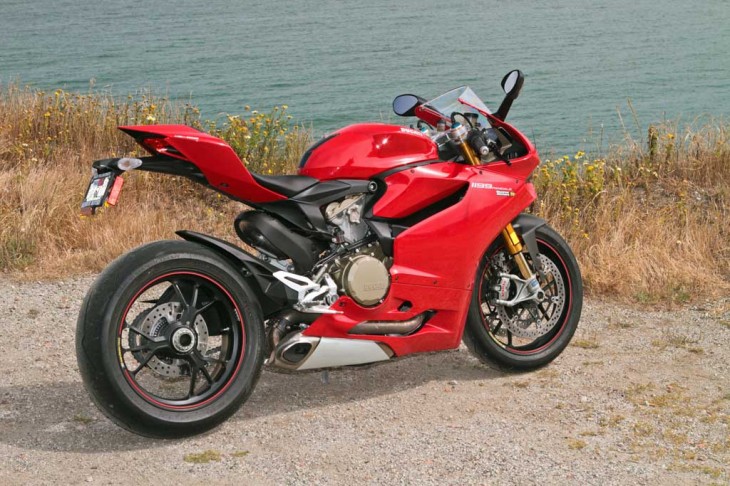
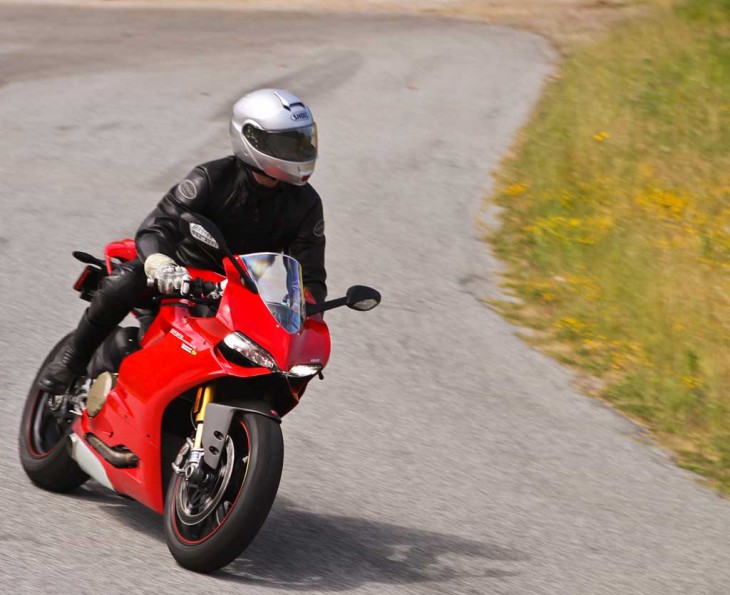
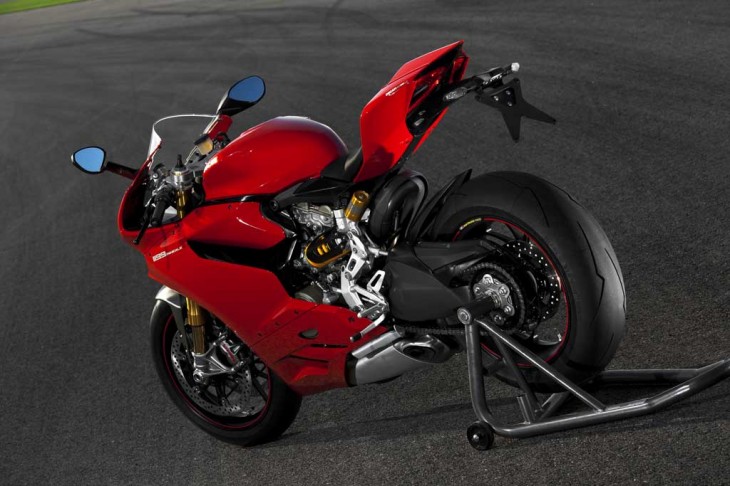
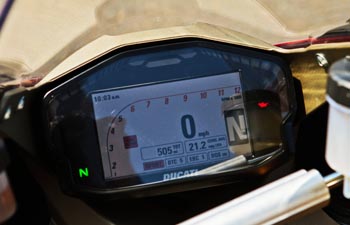
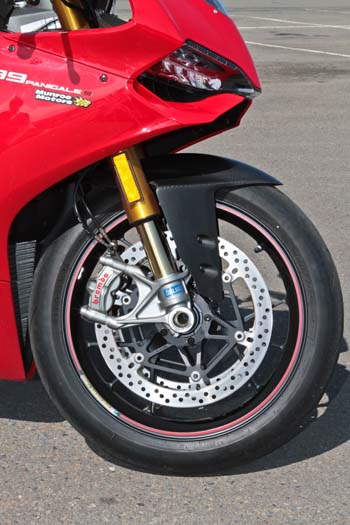
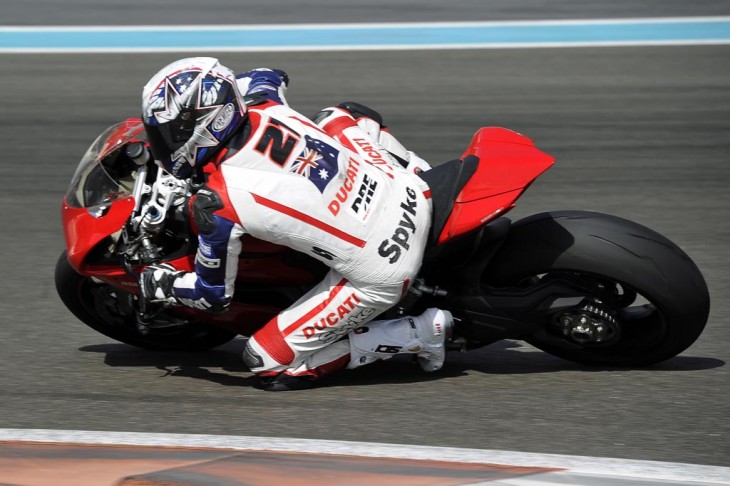






well done.. one of the best super sportbikes ever from Ducati… but I still loving the Classic 1000. ..
I also find all the negativeness spewed here and in other forums as doing nothing for the sport. I guess that’s what you get when you have a great wide open Internet with so many with nothing good to say about anything except that which meets their ever changing criteria. I’m more than sure most of us would find the ride thrilling and would love to have one in the stable.
In case ya didn’t know Panigale is the suburb of Bologna where Ducati make their bikes.
So I guess we can soon expect releases of such products as the Kawasaki Chūō-ku, Honda Minato-ku, Suzuki Hamamatsu and the Yamaha Iwata, along with the Triumph Hinckley, BMW Berlin, and of course the Harley Davidson Milwaukee. 😉
So many complaints from people who have likely not even seen one in person, much less ridden one…and it’s in it’s first year of developement to boot. I wonder how many of you poo pooing the electronics package would have been, years ago, lamenting the passing of the hardtail for all that new-fangled suspension crap. I mean, all ya need is a good sprung seat to ride it like a man right?
If you hate it, hate the electronics, or don’t think it offers the value of a Japanese bike, that’s fine, this is obviously not the bike for you. Some of us would like the choices to be offered to us; to have a cutting edge, near WSBK caliber, motorcycle for the same price as a Nissan Sentra. I know I would.
re: “to have a cutting edge, near WSBK caliber, motorcycle for the same price as a Nissan Sentra. I know I would.”
ahem you’re missing the critcal USP… “a cutting edge, near WSBK caliber, (ITALIAN) motorcycle for the same price as a Nissan Sentra”.
the unspoken secret behind why many choose to consume Ducati is because they know they don’t have a snowball’s chance in hell of ever affording a Ferrari. in that context, R models and even the D16 are steals. 🙂
But in the past couple of years, the Japanese didn’t need factory specials to lap quicker than the 1198. Most liter bikes were quicker around a racetrack. Period.
This new bike has so many electro gizmos on it it sorta takes away what makes riding a bike quickly special. Here we are all begging MotoGP to get rid of electric nannies, and now Ducati comes out with a street bike with loads of them. Thanks…but no thanks.
Who would have ever thought that Japanese bikes would be thought of as more pure than an Italian bike? With the introduction of the Panigale, this is now the truth.
word….
there goes another connection:
DUCATI – BUGATTI.
it rhymes, doesn’t it ?
Leistung fuer die Volks (Folks).
the Panigale seems to be just TOO good.
a proof that you can overdo things.
however, with all those electronics on board, you can choose
to set it up intentionally SO WRONG, that it might actually
become entertaining, characterful, irrationally-scary, and likeable.
though I haven’t ridden it, I’m 100% positive that the Panigale
must be actually best to ride when using the 120 RWHP setting –
in that setting, perhaps, a mere mortal rider could probably
find a track where the bike’s dynamic potential might be
experienced (near) completely.
in sheer terms of marketing and ability to sell, however,
this “overkill” smell might be the new proper direction,
as the potential superbike customers of today are of the
“bestest, fastest”, superlatives-frustrated bunch, that WILL
buy anything as long as it has the best boasting-at-the-bar potential,
whereas the real riders tend to stick to ‘600’, ‘675’ and ‘750’ figures,
(and some of us are actually starting to painfully miss the ‘400’
figure, and looking more and more into ____.co.jp URLs).
so Ducati (er.. Volkswagen) will probably sell lots of these, again
making the notion of the high initial investment perhaps not so wise, rarity/exclusivity wise.
anyway, much more of an engineering marvel, than a REAL motorcycle.
just think of it as a Bugatti (er.. Volkswagen) Veyron on two wheels.
even the styling is.. kind of.. suspicious – on both.
re: “I’m 100% positive that the Panigale must be actually best to ride when using the 120 RWHP setting”
1 button push and thoughts of an 849 middle-weight become moot.
Ed Milich: I enjoy your articles in Motorcyclist. Good review Gabe et al.
Buy the Honda CBR1000RR, go faster on the track and save a bucket of cash. Simple as that, don’t over complicate things.
Buy the CBR1000RR, go faster on the track and save a bucket of cash. Simple as that, don’t over complicate things.
When I first saw photos of the Panigale I was quite disappointed. I didn’t think it looked nice at all. And I was sad about the wet clutch, and I was sad about Ducati’s trend of going far more oversquare to get the revs. On a personal level, I like the sound of the older bikes – the booming exhaust. The newer, oversquare (Testastretta) engines had so much mechanical noise and gone was the boom… but at least they looked nicer than the 999 (go away terblanche).
HOWEVER I have been gazing at one parked often near my house down at Kezar stadium and it looks so droolingly amazing in person. It’s a work of art. And yes, I understand and appreciate the move to wet clutch, higher revs, etc. etc. etc. Part of a bike is the sex appeal and I was afraid it was dissipating… nothing could be further from the truth. This bike is gorgeous. I want.
I’m not a fan of Ducati but I must admit, it’s a beautiful bike with a new design/frame/electronic features and on top, it’s more comfortable than the previous generations.
Price wise, it’s not that much more (if you take the standard 1199, not the ”S” model) than the other superbikes (CBR/GSXR/R1/ZX10/RSV etc…).
But to be honest, I would buy a new CBR1000RR before a Duc 1199 but the 1199 is still some sort of jowel, no? I have no doubt that the 1199 will find buyers/owners who will cherish them.
We are, riders, lucky to have so more options/choices when it’s time to buy a motorcycle.
Pick the one you like…
Buy a brand new Honda CBR1000RR and a brand new Panigale 1199. Ride each one at least 100 miles a day, every day, for five years. Then get back to us on which bike you like better. My money’s on the Honda.
Motorcycle USA just did a very in depth comparison of a number of bikes both of street and track and the Honda beat the BMW and the Ducati.
It would be my first choice too.
That and enough money left over to go see a few races around the country.
Not the point. I had a CBR1000RR Repsol and still have my Ducati 1098 as my track bike. I also have a new Multistrada as my daily ride. I’ve put in a few test rides on the Panigale now, including some track laps. Yep, the Honda is easier to ride and more comfortable than either of the Duc superbikes (although my Multi shames it in ease of riding and handling). It will always be the more compliant street superbike. BUT…on the track it is no contest, and that is where the Panigale is truly aimed.
No, it’s completely the point. The Honda’s faster on a track. You could say the Ducati was more fun or sounded nicer and gotten away with it. But on the track it’s all the objective bits that matter. The Honda posted the fasted lap in the hands of the “novice” rider (who is probably still faster than you and I) and the second fastest time in the hands of the expert, with only the ZX10R beating it. You could’ve argued about the test being unfair on the track with the bikes having racing exhausts fitted, but if anything, the Duc had the bigger advantage of a complete factory provided racing can and engine map.
And I also agree with the first poster on reliability, as I’ve owned a Ducati myself. It’s Italian, and bits WILL fall off.
Sheesh, you aren’t placing any credence in those muppets over at MotorcycleUSA are you? They test modified bikes in various stages of modification. What is the point of that? The BMW was completely stock. The Ducati had Termignonis. The Honda was heavily modified by the dealer. Who knows what they actually did. Test was a complete waste of time.
every race series has rules…magazine comparos, not so much. It would SEEM obvious to test them stock out of the box, only alowing suspension adjustments. Even the tire selection is part of the stock bike.
Also – thank goodness there are more than 51 flavors – to satisfy individual tastes. One bike may ignite your passion and that would justify spending more, TO THAT PERSON. Practicality doesn’t always trump the decision making process… Besides, what if you live in a place where every Doosh is riding a CBR and you don’t want to join their Doosh Gang???
You did read the article, didn’t you? They stated the type of exhaust and level of tuning. Yes, I agree that the Beemer was handicapped by beeing stock, but I was comparing the Honda to the Ducati here. If anything, the Duc with it’s factory Term can + factory USB re-map stick was was higher strung the the CBR + Akrapovic + PowCommander.
…and I’m willing to bet that the CBR would probably just beat the Beemer even if both had a similar “stage 1 superstock” level of tuning, just like Steve Rapp showed with in the last shootout (where both bikes were stock, I believe) People tend to discredit the Honda way too easily. True, it’s soulless, but I hear that’s just how racers like it, since it’s predictable lap after lap. That mass centralization and drivetrain count for a lot.
There’s a reason why that CBR is preferred by road-racers (think IoM TT). I’m pretty sure that if Honda actually bothered giving the same amount of support in WSBK that BMW gives it’s team, it’d be up there as well. But then again, it seems the factories seem to prioritize different markets when it comes to superbike racing. Yamaha seem to get behing teh Graves team in the states, Honda seem to like BSB and Irish road racing, while BMW and Aprillia take the WSBK route.
what i find most interesting from that comparo is the bike that (on paper) has far and away the LEAST amount of hp (148hp) while carrying far and away the MOST amount of weight (478lbs), just so happens to be the current 2X defending AMA champ…!? is the current defending BSB champ…!? and also managed to lift the WSBK crown on it’s debut while being ridden by a rookie to the series and it’s tracks…!? and as if all this weren’t enough, need i mention this SAME bike also managed to reset the pole position record that year to 11…!! the bike of course is yamaha’s R1. so much for test data.
Gutterslob, are you that naive (as are the Motorcycle USA boys) to believe that a modified bike turns up from the distributor and you believe they ONLY modified the bike according to the rules. You go on believing the Honda is the fastest at the track but it goes against almost every test out there which says the BMW and Aprilia are virtually in a different league and now the Panigale is looking like it will join them.
After reading the motorcycle-usa shootout and motorcycledaily’s review, I can only scratch my head and think, Are they taking about the same bike?
For $23K you get Ferrai 458 Italia looks, sounds and performance – in a beautiful bright Italian red package. Sure its more than you need on the street and belongs on the track – That’s the whole point!
I wish I was younger and had more disposable income. What I dream about is a bike that looks sounds and performs like this and is as comfortable as the Multistrada – the shift on the fly suspension is a must have on this kind of bike!
I traded in my ’07 1098 to a 1199 recently. I have ~300 miles on the new bike and I love it. I liked the 1098 I lot, but it was hard to drive slow in traffic, mirrors were useless, clutch was – typical ducati.
The new bike is much better (power, clutch, ergos, mirror), but it has some unexpected shortcomings:
– it’s loud. It’s so loud that you need earplugs for a ride longer than 30 min. It’s more engine noise than exhaust, but the exhaust is much louder compared to the 1098 as well.
– it’s hot. the pipe under the seat is so hot, that you feel it even at highway speeds
– I noticed the smoke at startup as well
– minor glitch is the turn-signal cancel triggering the mode-switch (it only happens at slow speeds)
Gabe, did I read that correctly, 4’9″? 😮
I had no idea who Joanna Krupa was, so I Googled here. Oh man I’m glad I did.
Also, I’m too cheap, old and fat for this bike (and Joanna too!), but what an object of lust. I love Ducati, though I’ve never owned one and likely never will. I’m glad someone has the balls to take bike technology up a few notches. I think the Japanese manufactures are playing it safe the same basic bike year after year (only better, for certain) – Ducati basically threw out all of their “heritage” and swung for the fences with this bike. They went for it, and it sounds like it paid off.
So so cool.
What doesn’t make sense is to have two gentlemen with the mentality of old geezers review a bike like this. Thanks for the buzzkill dudes!
Can you expand on that? What do you mean specifically?
It’s ’cause only old Geezers can afford it, and in my opinion, have a better likelihood of being able to appreciate it.
Kinda like wasting a world-class cigar on a 17-year-old.
That’s just plain harsh!
Actually, for “gentlemen of a certain age” their assessments of the Panigale were surprisingly positive. Did you read their reviews?
Ducati should just throw in the smaller front sprocket with every purchase because that’s the first thing any new Duc owner changes.
They are always geared to the moon.
One of the stupidest YouTube videos I ever saw was a man self-identified as “Fireman1291” in Florida. His friend video recorded him receiving the Panagale bike from the Florida Ducati dealer to test ride, and riding the Panagale at about 170+mph on easily-identified Florida freeways (with all due respect to true road racers in Florida, as expected, this doofus Floridian probably could not corner at speed if his life depended on it). He passed caged drivers going an estimated 70mph like they were literally in reverse…and I’m using the word “literally” in its literal sense, not the figurative/metaphorical usage.
The video was indeed proof of multiple major felony crimes. Other videos showed his face, making a conviction a slam dunk. I later looked again at the Ducati Monster forum where he posted the video. He deleted the video, apologized for it, and wrote that he always obeys the law.
Yes, and as Madonna once said, “Maybe donkeys may fly out my ___.”
Anyway, I have to admit, I’d never seen straight-line street performance like that ever, and I’ve seen a lot of fast bikes.
Too. Much. Money. For that kind of cheddar, it better be good!
I can’t help but think that ANY Japanese manufacturer could make a sportbike as good (or likely better) for nearly $25K.
Cough. Cough. Eye roll.
Oh, and by the way: Ducati DID make the bike.
And, no, I’m not a Ducati Fan Boy.
The last gen 1098 is an incredible bike that sold for the same retail price as the 916 when it originally came out. The one in this article is the most expensive trim it will be sold in. So a base bike could probably be had for ~$17k?
The Japanese bikes are great, they’re just not into doing really high-end “option” bikes. It’d be interesting to see what an R1 endowed with the cost difference in upgrades would be, no?
Closest I’ve seen in the last few years were probably the Yamaha R1 SP and LE models. SP was black (with gold wheels, iirc) while the LE had that KR Yellow Anniversary paint-job, but even those two didn’t quite pack the same level of kit as a Ducati S model. They had Ohlins front and back, Ohlins steering damper and Marchesini wheels, but I don’t think there were any engine mods, and no bikes had electronic TC at the time. R1-SP variant might have had a power hike and slipper clutch, not 100% sure on that. Both sold out pretty quick, due to limited numbers.
Only other bike on a similar “trick” lever as Italian S and R models was probably the R7, though it was also equally high-roller in terms of entry buying cost.
There have been plenty of (very) expensive Japanese bikes: R7, RC45, NR750 etc. They were nowhere near the top performance-vice.
Man that underseat exhaust must be hot as hell considering it is on the bottom of the bike now. 🙂
Ah damn I even checked this baby out up close and still missed that exhaust routing.
Ha!